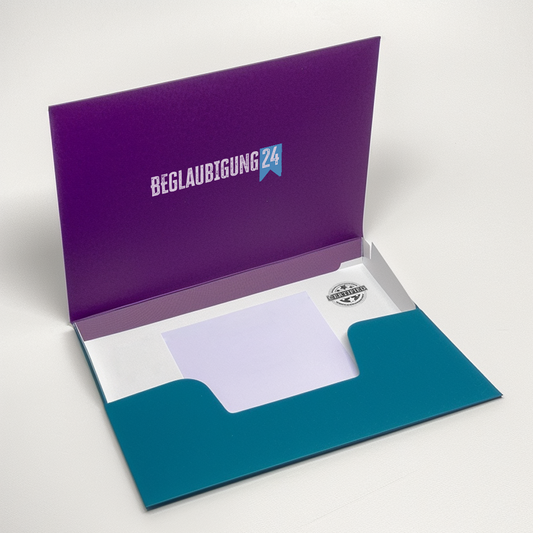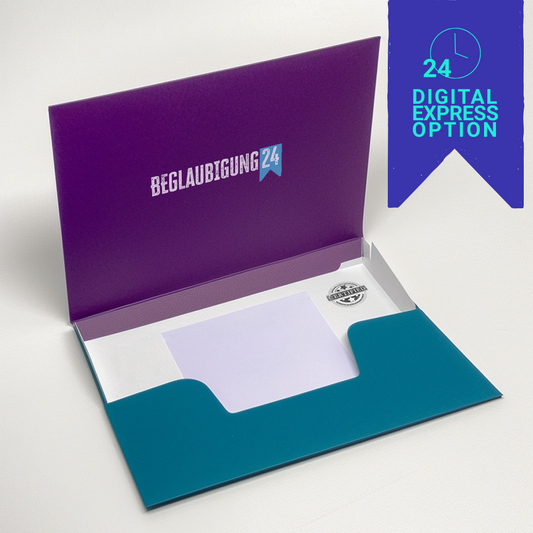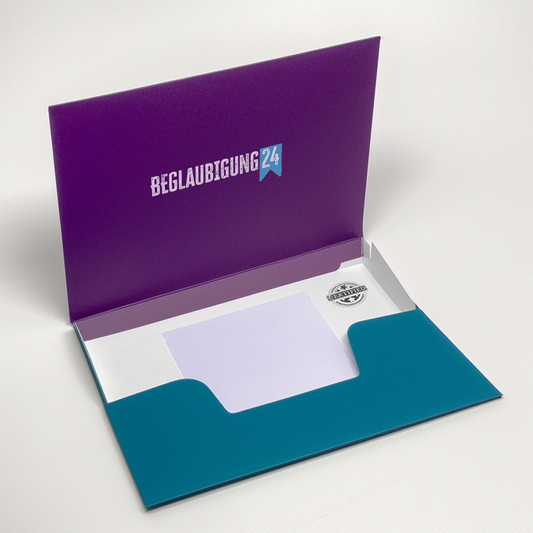Do you need a certified translation between Spanish and German? Our 3-step process makes it easy for you: Choose languages, upload document, see price. With our 100% recognition guarantee all documents are recognized by all authorities. What's more, you can order first and then pay conveniently upon receipt with Klarna.
View prices for Spanish translation now
We translate and certify these Spanish documents for you particularly frequently:
Choose from the most common document types for certified Spanish translation. You will receive your translated document digitally within a few days and by post if you wish:
-
Birth certificate / Certificado de nacimiento
Normal price From 44,90 € -
Certificate Certificado o Diploma
Normal price From 44,90 € -
Marriage certificate / Certificado de matrimonio
Normal price From 56,50 € -
Bescheinigung / Certificado o Comprobante
Normal price From 56,50 €
There are other documents that could be relevant for you and your Spanish-German translations:
-
NIE number: The NIE number (Número de Identificación de Extranjero) is your foreigner identification number in Spain.
-
Título de Bachiller (Spanish Abitur): The Spanish Bachillerato corresponds to the German Abitur, but is structured differently. For university applications in Germany, it must be translated and notarized.
-
Cédula de Identidad (identity card): In many Latin American countries, the identity card is called "Cédula de Identidad" (Colombia, Venezuela, Ecuador) or "Cédula de Ciudadanía".
-
Certificado de Antecedentes Penales (Certificate of Good Conduct): The Spanish/Latin American certificate of good conduct is often required for work permits. Important: It must be up to date and have both an apostilled and notarized translation.
Go to the document overview and start Spanish-German translation now!
That's why we are the first choice for Spanish translators
Recognition guarantee
100% recognized throughout Germany and internationally
Quick & easy
Order in 3 clicks - Express in 24h
Figures after receipt
Purchase on account possible
What do you need certified translations between Spanish and German for?
For Spain
- Residencia application (residence permit)
- Apply for an NIE number (foreigner identification number)
- Working in Spain (recognition of German qualifications)
- Buying real estate in Spain
- Draw a pension in Spain
- Marriage with a Spanish partner
For Latin America
- Emigration to Mexico, Argentina, Chile
- Business with Latin American companies
- Study in Latin America (very popular!)
- Dual citizenship (Spain, Argentina, etc.)
- Work visa for Latin America
- Investments in Latin American markets
As a professional Spanish translation agency, we understand the important differences between the various Spanish-speaking countries. Whether you need a German to Spanish translation for Mexico, Argentina or Spain - our experienced Spanish translators know the regional particularities and linguistic nuances that are important for an accurate translation. In Latin America in particular, forms of politeness and cultural customs vary considerably between the individual countries.
View prices for Spanish translation now
It's so easy to get your certified Spanish translation
You can order your German - Spanish translation online in just 3 steps:
Upload PDF & select languages
Upload your document securely to our platform and select the language combination (e.g. Spanish-German).
Select & order service
Standard (3-5 days) or Express (24-48h). Transparent price display without hidden fees.
Receive & pay for documents
Digital + postal delivery. Payment on receipt possible.
Differences between Spain and Latin America - what you need to know for a certified Spanish translation
Various formats
Spain: EU-standardized documents
Latin America: Every country has its own format - Mexican actas look different to Argentinian partidas
Various terms
- Spain: DNI
- Mexico: INE
- Colombia: Cédula de Ciudadanía
- Argentina: Documento Nacional de Identidad
Various authorities
Spain: EU directives, German documents often recognized directly
Latin America: stricter requirements, often additional apostille necessary
Apostille differences
Spain: EU apostille is usually sufficient
Latin America: Hague Apostille Convention - varies from country to country
Our most popular language combinations for certified translations
As a professional translation agency, we offer certified translations for many other languages in addition to Spanish:
Have your Spanish translation certified now
Frequently asked questions and our answers
Do I need a certified translation for the NIE application?
Price: From € 56.50 - Delivery time: 3-4 working days.
Will my German birth certificate be recognized in Mexico?
1. A certified translation into Spanish (we will do this for you)
2. An apostille from the German office (you must apply for this separately)
With our 100% recognition guarantee, your translated birth certificate will work with all Mexican authorities.
Why are prices for Latin American documents sometimes different?
Can I work with your translation in all Spanish-speaking countries?
Ready for your certified Italian translation?
Whether it's a birth certificate, certificate or business contract - we translate your documents professionally between Spanish and German. Officially recognized and legally valid.
Order a certified translation now
Do you need a simple translation without notarization?
Then visit uebersetzungsbuero24 .de - fast, easy, at a fixed price per page.
For a simple translation →











